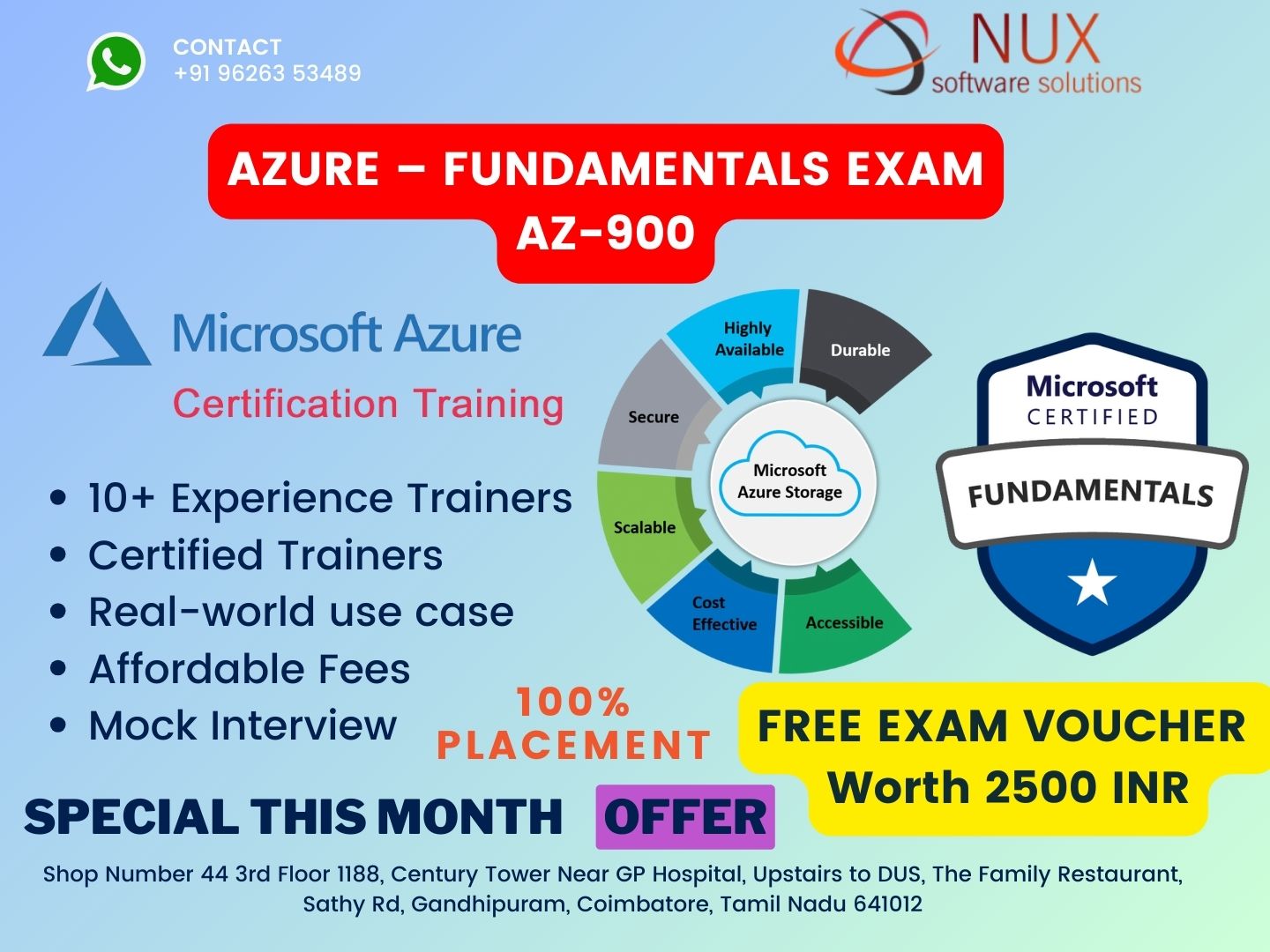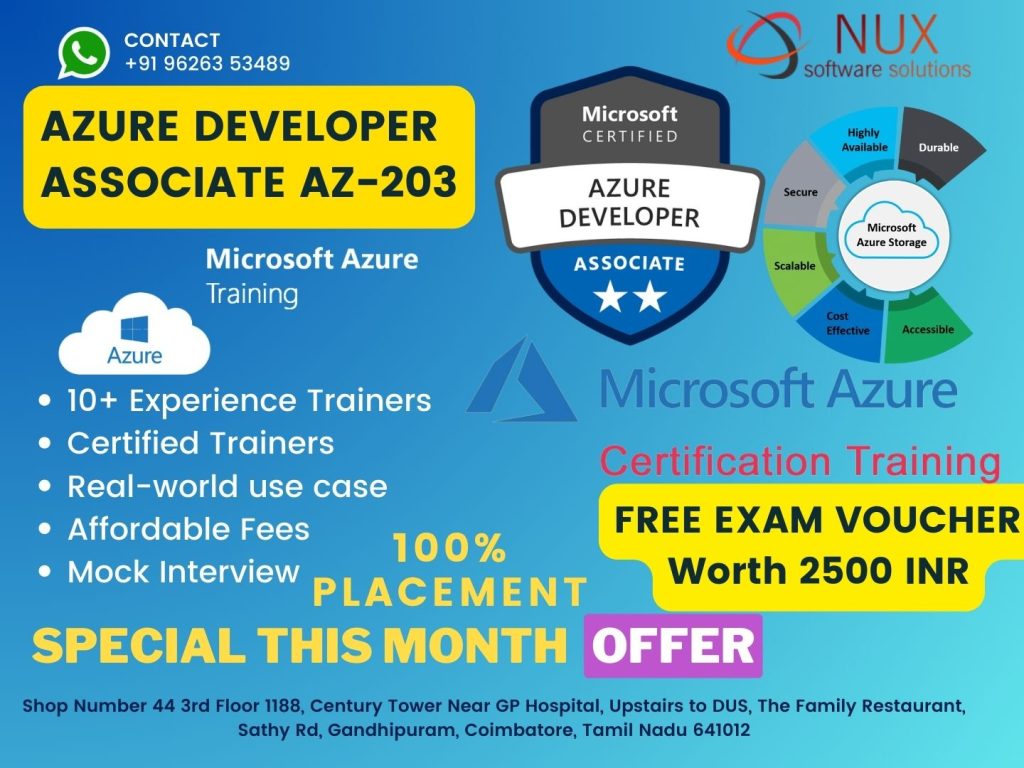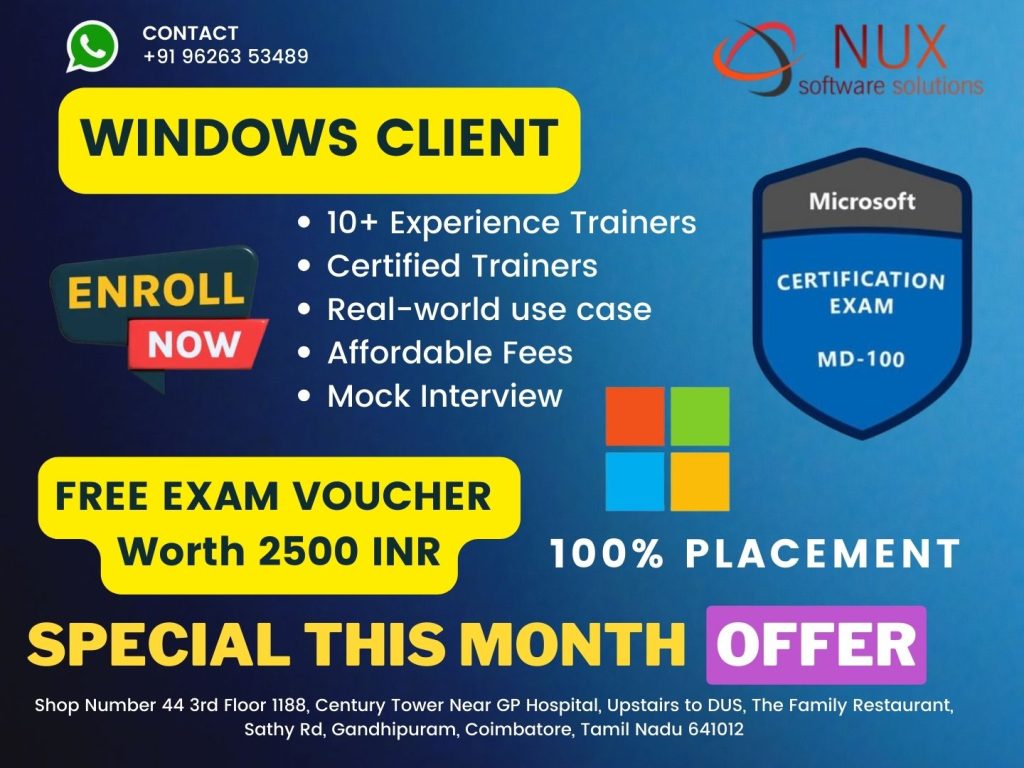Microsoft Certified: Azure – Fundamentals Exam AZ-900 Training and certification

AZ-900: Microsoft Azure Fundamentals Training in Coimbatore
Course Overview
The AZ-900: Microsoft Azure Fundamentals certification course is the perfect starting point for individuals who are new to cloud computing and Microsoft Azure. This entry-level course introduces core cloud concepts, Azure services, pricing models, compliance, and support—all tailored for beginners with no prior technical experience.
At Linux Training Center in Coimbatore, our hands-on, instructor-led AZ-900 training helps learners build a solid foundation in cloud technology, paving the way for more advanced Azure certifications and cloud-based career opportunities.
Why Choose AZ-900?
AZ-900 is not only a beginner-friendly course but also a globally recognized certification that validates your understanding of cloud concepts and Azure fundamentals. Whether you’re a student, IT professional, business user, or decision-maker, this course gives you the clarity needed to understand how Azure works and why it matters in modern enterprises.
It is highly recommended before pursuing role-based certifications such as Azure Administrator, Developer, or Security Engineer.
Who Should Enroll?
This course is ideal for non-technical professionals, fresh graduates, sales teams, project managers, and IT beginners who want to understand the cloud from a business and technical perspective.
No prior IT or cloud experience is required to enroll in this course.
What You Will Learn
Core cloud concepts and types of cloud models (IaaS, PaaS, SaaS)
Introduction to Microsoft Azure services and solutions
Basic Azure architecture and core management tools
Overview of Azure pricing, SLAs, and lifecycle management
Concepts of security, governance, compliance, and trust in Azure
Navigating Azure Portal and using Azure Resource Manager (ARM)
Learners gain real-time exposure to navigating the Azure platform through guided demos and hands-on labs.
Course Highlights
Beginner-friendly syllabus aligned with the AZ-900 exam objectives
Instructor-led training with simplified, real-world explanations
Live practical sessions using Azure Portal
Suitable for both IT and non-IT learners
Available in weekday and weekend formats
Career Opportunities
While AZ-900 is a foundational certification, it enhances your resume by showing that you understand the basics of cloud computing and Microsoft Azure. It opens pathways into cloud support, pre-sales roles, project management, and further certifications like Azure Administrator Associate (AZ-104) and Azure Developer Associate (AZ-204).
Why Linux Training Center?
Linux Training Center in Coimbatore specializes in beginner-to-advanced cloud training. Our AZ-900 program is delivered by certified trainers with real-world cloud expertise, ensuring every learner gains practical knowledge, confidence, and certification support.
Microsoft Certified: Azure - Fundamentals Exam AZ-900 Syllabus
Modules
Describe cloud concepts (25–30%)
Describe cloud computing
- Define cloud computing
- Describe the shared responsibility model
- Define cloud models, including public, private, and hybrid
- Identify appropriate use cases for each cloud model
- Describe the consumption-based model
- Compare cloud pricing models
Describe the benefits of using cloud services
- Describe the benefits of high availability and scalability in the cloud
- Describe the benefits of reliability and predictability in the cloud
- Describe the benefits of security and governance in the cloud
- Describe the benefits of manageability in the cloud
Describe cloud service types
- Describe infrastructure as a service (IaaS)
- Describe platform as a service (PaaS)
- Describe software as a service (SaaS)
- Identify appropriate use cases for each cloud service (IaaS, PaaS, SaaS)
Describe Azure architecture and services (35–40%)
Describe the core architectural components of Azure
- Describe Azure regions, region pairs, and sovereign regions
- Describe availability zones
- Describe Azure datacenters
- Describe Azure resources and resource groups
- Describe subscriptions
- Describe management groups
- Describe the hierarchy of resource groups, subscriptions, and management groups
Describe Azure compute and networking services
- Compare compute types, including container instances, virtual machines (VMs), and functions
- Describe VM options, including Azure Virtual Machines, Azure Virtual Machine Scale Sets, availability sets, and Azure Virtual Desktop
- Describe resources required for virtual machines
- Describe application hosting options, including the Web Apps feature of Azure App Service, containers, and virtual machines
- Describe virtual networking, including the purpose of Azure Virtual Networks, Azure virtual subnets, peering, Azure DNS, Azure VPN Gateway, and Azure ExpressRoute
- Define public and private endpoints
Describe Azure storage services
- Compare Azure storage services
- Describe storage tiersd
- Describe redundancy options
- Describe storage account options and storage types
- Identify options for moving files, including AzCopy, Azure Storage Explorer, and Azure File Sync
- Describe migration options, including Azure Migrate and Azure Data Box
Describe Azure identity, access, and security
- Describe directory services in Azure, including Microsoft Azure Active Directory (Azure AD), part of Microsoft Entra and Azure Active Directory Domain Services (Azure AD DS)
- Describe authentication methods in Azure, including single sign-on (SSO), multifactor authentication, and passwordless
- Describe external identities and guest access in Azure
- Describe Conditional Access in Microsoft Azure Active Directory (Azure AD), part of Microsoft
- Describe Azure role-based access control (RBAC)
- Describe the concept of Zero Trust
- Describe the purpose of the defense in depth model
- Describe the purpose of Microsoft Defender for Cloud
Describe Azure management and governance (30–35%)
Describe cost management in Azure
- Describe factors that can affect costs in Azure
- Compare the Pricing calculator and the Total Cost of Ownership (TCO) calculator
- Describe the Azure Cost Management and Billing tool
- Describe the purpose of tags
Describe features and tools in Azure for governance and compliance
- Describe the purpose of Azure Blueprints
- Describe the purpose of Azure Policy
- Describe the purpose of resource locks
- Describe the purpose of the Service Trust Portal
Describe features and tools for managing and deploying Azure resources
- Describe the Azure portal
- Describe Azure Cloud Shell, including Azure CLI and Azure PowerShell
- Describe the purpose of Azure Arc
- Describe Azure Resource Manager and Azure Resource Manager templates (ARM templates)
- Configure backup and recovery of certificates, secrets, and keys
Describe monitoring tools in Azure
- Describe the purpose of Azure Advisor
- Describe Azure Service Health
- Describe Azure Monitor, including Log Analytics, Azure Monitor alerts, and Application Insights
Describe Artificial Intelligence workloads and considerations (20-25%)
- Identify features of anomaly detection workloads
- Identify computer vision workloads
- Identify natural language processing workloads
- Identify knowledge mining workloads
- Describe considerations for fairness in an AI solution
- Describe considerations for reliability and safety in an AI solution
- Describe considerations for privacy and security in an AI solution
- Describe considerations for inclusiveness in an AI solution
- Describe considerations for transparency in an AI solution
- Describe considerations for accountability in an AI solution
Describe fundamental principles of machine learning on Azure (25-30%)
- Identify regression machine learning scenarios
- Identify classification machine learning scenarios
- Identify clustering machine learning scenarios
- Identify features and labels in a dataset for machine learning
- Describe how training and validation datasets are used in machine learning
- Automated machine learning
- Azure Machine Learning designer
Describe features of computer vision workloads on Azure (15-20%)
- Identify features of image classification solutions
- Identify features of object detection solutions
- Identify features of optical character recognition solutions
- Identify features of facial detection and facial analysis solutions
- Identify capabilities of the Computer Vision service
- Identify capabilities of the Custom Vision service
- Identify capabilities of the Face service
- Identify capabilities of the Form Recognizer service
Describe features of Natural Language Processing (NLP) workloads on Azure (25-30%)
- Identify features and uses for key phrase extraction
- Identify features and uses for entity recognition
- Identify features and uses for sentiment analysis
- Identify features and uses for language modeling
- Identify features and uses for speech recognition and synthesis
- Identify features and uses for translation
- Identify capabilities of the Language service
- Identify capabilities of the Speech service
- Identify capabilities of the Translator service
- Identify features and uses for bots
- Identify capabilities of the Power Virtual Agents and Azure Bot service



